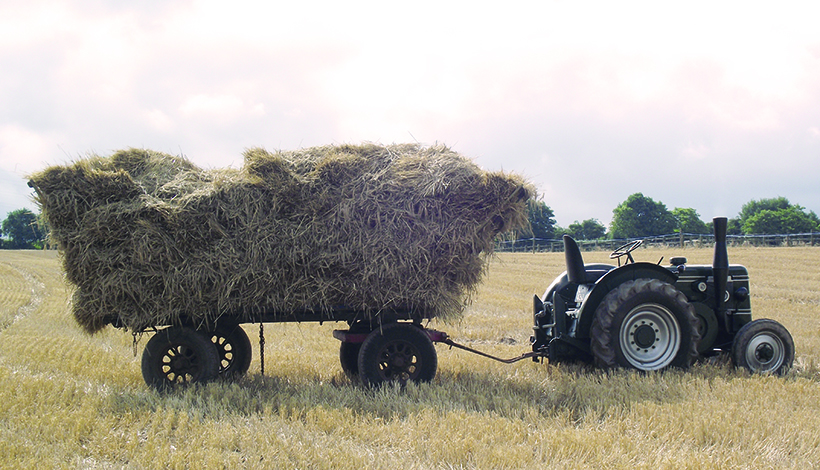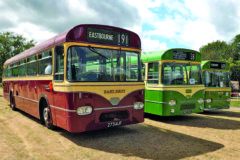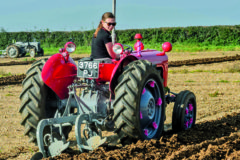A vintage harvest
Posted by Chris Graham on 8th October 2020
Ben Phillips reports on a fantastic day spent celebrating the romance associated with farming from a time long gone.

A vintage harvest: The fully-laden wooden cart being towed around by a beautiful, Field Marshall tractor.
Some say that all the romance has vanished from farming, but there are others who, recalling the bygone era as nothing more than gruelling, hard work, maintain it was never there in the first place. But I still think that it’s still great to travel back in time every now and then, just to get a flavour of how things were done back in the mists of time, and to enjoy a vintage harvest.
There’s no doubt that farming in the 1930s and ‘40s was hard work, but I imagine that the camaraderie among the workers was brilliant, with great friendships made that lasted a lifetime. Today’s farm worker has little more than a radio, or the animals being managed, for company.

It takes a few adjustments to alter the binder from its transport setting to its harvesting setting; mainly, the road wheels need to be removed.
The past returns
Time machines, unfortunately, don’t exist, so we can’t step back in time and visit those rosy days of harvest from 70 or 80 years ago. However, we can see how it was done by the machines that did it and, guided by the people who remember how it all happened, we can recreate a whimsical scene from the past.
In my home village of Trimpley one July, I got a first-hand experience of what harvest time was like decades ago, at one of the annual shows. The corn is cut with a binder and the sheaves stoked before being threshed and baled. Helping with this kind of work, I got a sense of why the harvest was such a special time of year. The DVD The Crown of The Year is a great old film, and its final part focuses on gathering in the corn. The entire film builds towards this most important time of year.

Seeing the golden corn being cut is a lovely sight; corn is grown a lot thicker and shorter these days, so the conditions now are slightly different compared to when the binder was new.
The binder that was being used here was a McCormick E8, made at Hamilton, in Canada. Cyrus H McCormick was at the forefront of making reapers to harvest grain so, by the time this model was introduced, the practice of making such machines was well perfected. Watching the owners preparing the machine, it’s clear that the set-up is a well-oiled process. The road wheels are removed and replaced with the working ones. The sails that direct the corn into the cutter bar are bolted into place, then the canvasses are tightened. Twine is threaded through the knotters if there’s none still left from the last time it was used.

Despite being an old machine, the binder still produces a lovely cut, Ron Bebb (far right) keeps an eye on proceedings.
Evocative binder
A lot of the binders still in use today have been converted to PTO-drive, as opposed to relying on forward motion to make them work, as would have been the case when they were pulled behind a horse. I love seeing an old binder working. The clatter of the working parts as it cuts through the golden corn, and the motion of the cut stalks as they wave in the wind, is simply magical. Then, via the canvases, they’re taken to be knotted, after which they’re suddenly spat out of the side. A wonderful sight.
Depending on how fast the binder is travelling, the sheaves come thick and fast and, for those of us following, it’s a full-on job to keep up, even with a few people helping. Historically, the corn was cut slightly under-ripe and stoked, then left in the field until three church bells had been heard – so probably three Sundays. The way the stooks were set in the field allowed the breeze to waft through so that they ripened as the weeks passed. My grandad, who did such a job, told me that everyone involved placed each sheaf in exactly the same place in every stook.

This is what the binder produces; a nice, well-balanced sheaf that’s simply tied around the centre with some jute-type twine.
Stacked high
Once the stooks have been out for the appropriate amount of time, the next stage is to cart them. In this case, it was just to the threshing box. It seems that carts have to be stacked high with someone perched on top of the load, while people with pitchforks hand the sheaves up to them. Being on the cart it’s not hard to see how quickly loads get high, as the sheaves come from all directions from the many helpers, you don’t get time to notice how high it’s getting.
Soon you’re bouncing around on top of a surprisingly sturdy load, and in need of a ladder to get yourself down off it. The wooden cart used here is being towed around by a beautiful Field Marshall tractor. The distinctive thump, thump, thump of the engine is from a different time. No other tractor makes this kind of sound. Also, just to remind us of how things were even before the Field Marshall came along, there’s a horse-drawn cart being loaded. The horse is calm and when it’s told to walk-on, it does with just the sound of the hoofs crunching through the cut stalks.

This cart is familiar to me from old farming films I’ve seen. It’s stacked nice and high and, anyone working on the top will need a ladder to get down.
Brightening-up
At the bottom of the field, there was another Marshall, this time a bright pink threshing box. Machines of this era really were brightly-coloured; it’s no wonder the workers were happy! But probably what made them happiest was the cider on offer, as most farms in those days had a good orchard and cider was made in abundance and served during harvest. It was more than likely rough cider but, all the same, it would have been welcomed by the workers on a hot day.

In Worcestershire, these are called ‘thripples’, and allow for a good load to be carried on a wooden cart.
A lot of farms couldn’t afford their own threshing box, so one would probably visit many farms during a season. In certain areas, the day the threshing box came was called a ‘turn out’, and everyone would turn out to help – maybe even the vicar! It was quite an occasion and the job was completed with great community spirit. Watching the threshing box work, your eyes don’t know where to look first – they’re drawn all over the machine. Belts are moving and pulleys are turning everywhere. There are no safety guards on any of the working parts, so keeping your wits about you when walking around the box is essential.

Brightly-coloured machines were the norm in the era this threshing box was made, and this pink Marshall was certainly one of the brightest I’ve seen!
The longest belt goes to the tractor that powers it; in this case, a Field Marshall is doing the honours. As you get around the front, there’s a big pile of chaff on the ground that’s largely useless; this is the waste from when the grain is separated. It’s very fine and dusty and, on old films, you’ll see a bonfire in the vicinity smoking away, burning this.
A magnificent sight
On the very top of the threshing box, in big black letters, is the word ‘Marshall’. If you look below this, and more closely, you’ll see a metal badge confirming that Marshall Sons & Co built this magnificent bit of kit. Also, on the badge, in brackets, the words ‘successors to’ tell us it’s a 2nd or 3rd generation making this and, as you read on, the word ‘engineers’ is proudly displayed.

What better tractor to power a threshing box than the iconic Field Marshall? The familiar thumping of its single-cylinder engine is a great sound to hear in any field.
On a separate part of the machine, another metal badge informs onlookers who the machine’s agent was. In this case it was W Powell, from Bridgnorth, meaning that this was a local machine – we’re only 10 minutes away from that particular, Shropshire market town.
Parked next to the threshing and box receiving the straw, was a baler. I like these old machines as you can see and hear everything working. The ram sliding backwards and forwards dominates proceedings. Once again, there are no safety guards to hide what’s going on, and the whole baler looks a bit like a nodding donkey when it’s working. Before the baler was used commonly, the straw would have been stored loose, which would have taken up a lot of valuable space. But the neatly-compacted bales could be stored much more efficiently, in easy-to-build stacks. The bales of yesteryear were bound with wire – rather than the sort of baler twine used today – which was twisted to fasten, rather than being knotted.

Sitting next to the box is the baler; the straw falls from the top and makes its way to the ram, which transforms it into a good-sized bale.
These days, with modern combine harvesters, all of what you’ve seen here has been superseded, and these giant, modern machine are controlled by just one person. What’s more, the way things are heading, it looks as though even that single operator will be made redundant in the future as autonomous technology takes a hold.

Looking rather like a nodding donkey, the baler really saved time and was a great way to use up the straw.
I began this article by suggesting that the romance has been taken out of farming and, personally, I would say that, compared to the wonderful, community process I’ve seen here, that that is most definitely the case.
For a money-saving subscription to Tractor & Farming Heritage magazine, simply click here





